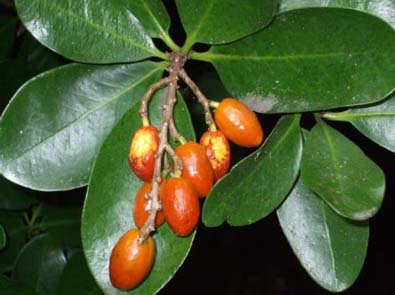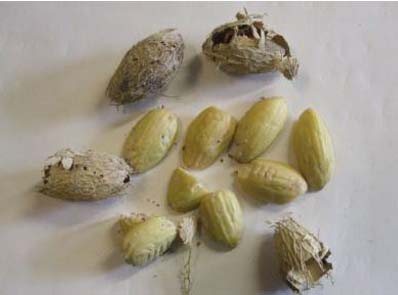| PROTO-POLYNESIAN ETYMOLOGIES |
| *Kōpī [Rarotongan+Māori] Kōpī [Māori] |
Zingiber zarumbet, "Shampoo Ginger" (Zingaberaceae) (Rarotonga)
Processed fruit of Corynocarpus laevigatus, "Karaka", or the tree itself (Aotearoa) |
|
| This word appears to have originated in Rarotonga. |
Proto Oceanic: *KawaRi (A root with special properties, e.g. Zingiber zerumbet & Piper subbullatum).
SEMANTIC PARALLELS / COGNATES IN SOME POLYNESIAN LANGUAGES:
Tongan: Angaango (Zingiber zerumbet, "Shampoo ginger", Zingiberaceae) (cf Proto-Oceanic *yangoyango "yellow")
Reflexes: Proto Nuclear Polynesian - *kava-pui:
Samoan: 'avapui (Zingiber zerumbet [Zingiberaceae])
Tahitian: Avapuhi (Z. zerumbet)
Marquesan: Kavapui (Z. zerumbet)
Hawaiian: 'awapuhi (Z. zerumbet)
Reflexes: New name - kōpī:
Rarotongan: Kōpī (Zingiber zerumbet)
Maori: Kōpī (Corynocarpus laevigatus [Corynocarpaceae] processed fruit &/or tree)
Moriori: Kōpī (The tree Corynocarpus laevigatus, "Karaka").
|

Zingiber zarumpet - Kawapuhi (Hawai'i), Kōpī (Rarotonga).
(Leafy stems
and stalk with bract. Wahinepe'e, Maui, Hawai'i. Photo: (c) Forrest & Kim Starr)
|

Corynocarpus laevigatus - Kōpī / Karaka (Aotearoa)
(Foliage & ripening fruit, Hamilton City, Waikato, NZ. Photo: (c) David Klinac)
|
|
|
|
|
SEMANTICALLY RELATED WORD IN AOTEAROA
Maori: Karaka ((Corynocarpus laevigatus, Corynocarpaceae), the tree bearing the NZ kōpī, and (in some districts and the Chatham Islands) the tree itself.
|
 Kōpī is the name given to the wild red ginger, Zingiber zerumbet, in Rarotonga. Elsewhere in Polynesia from Samoa east it is known by a reflex of an earlier word, *kavapui (or possibly *kavapusi). The new name, *kōpī, was adopted in Aotearoa for the ripe berries of the karaka (Corynocarpus laevigata) after they had been soaked in water as part of the treatment to remove the toxin. Both the ripe berries and the pulp would have been reminiscent of the flowering bracts of the Zingiber, like those illustrated above and on the left, which turn deep red as they mature. In some districts and the Chatham Islands the whole tree is known as kōpī. Kōpī is the name given to the wild red ginger, Zingiber zerumbet, in Rarotonga. Elsewhere in Polynesia from Samoa east it is known by a reflex of an earlier word, *kavapui (or possibly *kavapusi). The new name, *kōpī, was adopted in Aotearoa for the ripe berries of the karaka (Corynocarpus laevigata) after they had been soaked in water as part of the treatment to remove the toxin. Both the ripe berries and the pulp would have been reminiscent of the flowering bracts of the Zingiber, like those illustrated above and on the left, which turn deep red as they mature. In some districts and the Chatham Islands the whole tree is known as kōpī.
The ginger originated in Southern Asia, and was carried throughout Polynesia by its first explorers, possibly at different times and from different sources, as it is known by several quite unrelated terms, and apart from the most common East Polynesian term (from the same source as the words for "bitter" and "kava") none are related to a Proto-Oceanic or earlier inherited word. Despite its wide distribution elsewhere in Polynesia, this plant either did not reach Aotearoa or quickly failed to thrive here.
The leaves die down in the cooler seasons; the fully-grown shoots are a metre or more high, with the stalks carrying the shiny crimson bract emerging separately, without leaves. The white or pale yellow flowers emerge singly or in pairs. It is rarely cultivated, but instead left to grow wild in forest margins, disturbed ground or secondary forest and along tracks, where it is easily obtained when required.
It rarely fruits in many parts of its Polynesian range, but in the Marquesas it has small, red, egg-shaped fruits like a small karaka berries, which occasionally contain a small, black seed. However there as elsewhere it generally spreads vegetatively by means of its stout, aromatic rkizomes.
In Rarotonga the scented fluid from the bracts is used as a conditioning shampoo, and the grated rhizome is used to treat haemorrhoids. It is not used there for cooking -- a 19th Century introduction, Zingiber officinale, is used for that purpose. Elsewhere, however, it does have culinary uses. Warren Wagner et al. note that:
The fragrant sudsy
fluid from the inflorescence of this plant was used by the early Hawaiians as a shampoo, the powdered rhizome for scenting kapa [tapa], and the leaves were used to flavour meat. In addition, the ashes of the leaves were used medicinally. (Manual, p. 1264)
Isabella Abbott adds that in Hawaii ashes from the leaves and from 'ohe (Polynesian bamboo) were mixed with a little juice from kukui (candlenut) nuts, to treat cuts and sores. The underground stems were mashed with salt and rubbed over the afflicted part of the head to treat headaches (Lā'au Hawai'i, p. 102). The plant was used in similar ways in Tahiti. In Tonga it is known as Angoango, from Proto-Oceanic *yangoyango, "yellow", the colour of the rhizome. There the juice from the rhizome is used to treat mouth infections, as well as stomach ulcers and stomach aches (W.A. Whistler, Tongan Herbal Medicine, p. 59). In Rarotonga the word kōpī now refers to all introduced gingers.
In Aotearoa it refers only to Corynocarpus fruits and trees.
The New Zealand kōpī / karaka as a tree has a page to itself, where some information will also be found about how kōpī in the form of the karaka nut is prepared for eating. There are illustrations of this latter kōpī in the gallery below.
The Cook Islands biodiversity database has additional information and photographs of the Rarotongan kōpī, both the original wild ginger and recent introduced related species which have also been given this name. |

Zingiber zerumbet - Kōpī (Rarotonga) Awapuhi (Hawai'i). Bracts with flowers.
(Wahinepe'e, Maui, Hawaii. Photo: (c) Forrest and Kim Starr) |

Zingiber zerumbet - Kōpī / Kawapuhi. Bracts with spent flowers.
(Iao, Maui, Hawai'i. Photo: (c) Forrest & Kim Starr.) |

Corynocarpus laevigatus - Kōpī / Karaka (Aotearoa)
(Inflorescence. Hamilton, Waikato, NZ. Photo: (c) David Klinac.) |

Corynocarpus laevigatus - Kōpī / Karaka (Aotearoa)
(Ripe fruit. Hamilton, Waikato. NZ. Photo: (c) David Klinac.) |

Dried nuts of Corynocarpus laevigatus - Kōpī (Aotearoa)
(Photo: (c) David Klinac.) |

Shelled nuts of Corynocarpus laevigatus - Kōpī (Aotearoa)
(Photo: (c) David Klinac.) |
|
| Further information : Many of the general works on New Zealand plants and trees listed in the Bibliography will have material on the karaka, mentioning also the culinary and toxic properties of its fruits. The publication details of works mentioned in the text will also be found there. There are further references on the linked page for "Karaka". The Cook Island Biodiversity Network Database, Wikipedia, and the works by W. Arthur Whistler, along with the floras of various Polynesia countries listed in the bibliography are good places to start looking for information about the tropical plant. Websites with information on New Zealand plants include Robert Vennell's The Meaning of Trees, the New Zealand Plant Conservation Network, and the Landcare / Manaaki Whenua NZ Flora database, all of which have links to other sources of information. The University of Auckland School of Biological Sciences also has an excellent website dedicated to New Zealand native plants. |
| Photographs: The inset photo of a Kawapuhi bract was taken by Forrest and Kim Starr in Kula, Hawai'i. The sources of the other photographs are acknowledged in the captions. We are grateful to all the photographers for permission to use their work.
Citation: This page may be cited as: R. A. Benton (2023) “*Kōpī” (web page periodically updated), Te Māra Reo. "http://www.temarareo.org/PPN-Kopi.html" (Date accessed)
(Hoki atu ki runga -- Go back to the top of the page.) |

